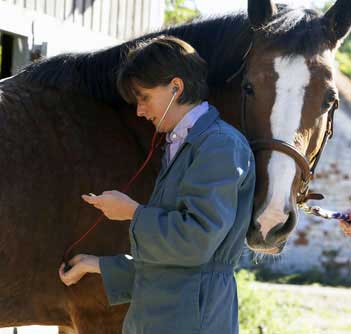Assessing Horse Vital Signs

Written by Preston Hickman, DVM, Wichita Equine and Sports Medicine
Equipment Needed:
Assessing an animal’s vital signs is easy, straightforward and can be done with minimal equipment. The only equipment needed are a thermometer and lubricating jelly. A stethoscope makes monitoring the heart rate and respiration easier.
Stethoscopes are a worthwhile addition to any emergency medical kit. Thermometers come in many different shapes and sizes from digital to manual. If a manual variety is chosen, a livestock thermometer with a string attached will make your life much simpler when taking the rectal temperature on a large animal.
Proper restraint is important no matter what animal you are assessing. The primary goal is safety of the handler and the animal. Ensure that the animal is in a comfortable location (if possible) before you began to assess the vital signs. It is always a good idea to have a practice run before you have an emergency, so you’re aware of how the animal will react. A practice run will allow your animal to know what to expect during the procedure, as well. Vital signs consist of primarily three things: temperature, pulse, and respiration. Other considerations are: Gastro-intestinal or G.I. sounds, digital pulses, mucous membrane color, and hydration status when confronted with an emergency.
Taking Vital Signs:
Temperature: With the animal properly restrained, apply a small amount of the lubricating jelly to the end of the thermometer. If using a manual thermometer, make sure the thermometer is shaken down prior to inserting into the rectum. Insert the thermometer approximately 3 to 4 inches into the rectum. Allow at least 2 minutes before reading and removing if using a manual thermometer, or until the digital thermometer beeps if using a digital thermometer. The string on a livestock thermometer can be attached to the tail so that it is not inadvertently lost into the rectum or dropped on accident. Caution should be used to assure the end of the thermometer is not within a fecal ball, as this will tend to falsify the reading in some cases.
- * Normal temperature for a Horse is 98.5-101 degrees F.
- * Normal temperature for a Dog is 99.5–102.5 degrees F.
- * Normal temperature for a Cow is 100–102.5 degrees F.
- * Normal temperature for a Sheep/Goat is 101–103 degrees F.
- * Normal temperature for a Rabbit is 100.4–105 degrees F.
- * Normal temperature for a Cat is 100-103.1 degrees F.
- * Normal temperature for a Swine is 100–102 degrees F.
Pulse: An animal's heart lies approximately behind the elbow. The pulse is easiest to detect by using a stethoscope on the left side of the animal’s body. It can be measured manually by finding an artery and palpating the pulse, much as you do on yourself when you palpate your pulse over your wrist. The horse’s pulse may be taken manually by placing your fingertips on the large artery up against the inside of his jawbone near his cheek. The dog and cat pulse is most easily detected at the femoral artery inside the flank of the hind leg. In other livestock such as sheep, cattle and swine, the use of a stethoscope rather than manually palpating the pulse is desired. The pulse (each lub-dub counts as one beat) can be counted for a minute, or can be counted for 15 seconds and multiplied by 4 to get the rate per minute.
- * Normal pulse rate in a Horse is 28-45 beats per minute.
- * Normal pulse rate in a Dog is 80–120 beats per minute.
- * Normal pulse rate in a Cow is 55–100 beats per minute.
- * Normal pulse rate in a Sheep/Goat is 60-110 beats per minute.
- * Normal pulse rate in a Rabbit is 20–150 beats per minute.
- * Normal pulse rate in a Cat is 100–140 beats per minute.
- * Normal pulse rate in a Swine is 60-120 beats per minute.
Respiration: Respiration is perhaps the easiest vital sign to obtain since no contact with the animal is required in order for it to be measured. In contrast, respiration is also the most variable of all the vital signs, and the most effected when the animal is excited or in pain. It is not uncommon for respiration rates to double or triple with pain or anxiety. Watch the animal’s flanks, counting every inhalation for 15 seconds. Multiply by 4 to get the rate per minute.
- Normal respiration rate in a Horse is 10–14 per minute.
- * Normal respiration rate in a Dog is 15–30 per minute.
- * Normal respiration rate in a Cow is 10–40 per minute.
- * Normal respiration rate in a Sheep/Goat is 10–30 per minute.
- * Normal respiration rate in a Rabbit is 50–60 per minute.
- * Normal respiration rate in a Cat is 20–30 per minute.
- * Normal respiration rate in a Swine is 8–18 per minute.
Take your animal’s vital signs over a number of days in different weather and temperature conditions. This will assist in establishing a baseline to interpret variations in values should the need arise.
About the author:
Dr. Preston Hickman practices veterinary medicine in Wichita, Kansas, specializing in equine podiatry and sports medicine. He combines traditional veterinary medicine with video gait analysis to diagnose physical problems and abnormal motion in horses. His experience as a farrier and chiropractor allow him unique perspective into biomechanical movement. Dr. Hickman has worked extensively with horse wellness issues as Assistant Medical Director for the Louisiana Racing Commission, overseeing four tracks and 16 veterinarians. Dr. Hickman has a background in mixed practice, equine and bovine veterinary medicine, as well as veterinary consultation to feedlots.


